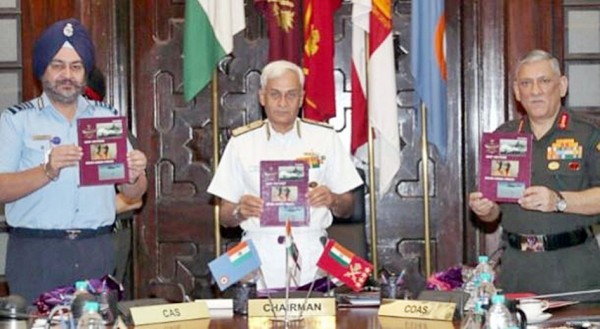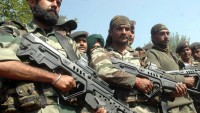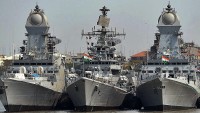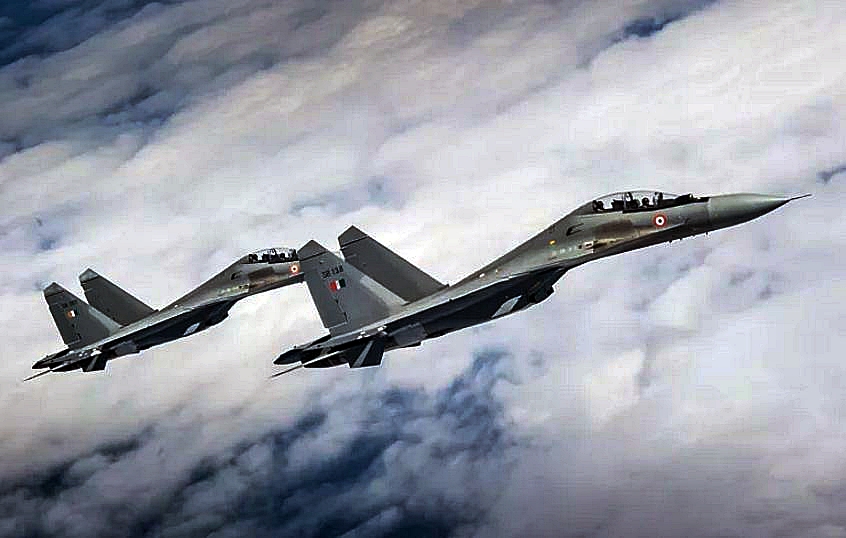New Indian Armed Forces Warfighting Doctrine Emphasizes Joint Operations; Use of Space and Cyberspace
| Arthur Dominic Villasanta | | May 04, 2017 07:45 AM EDT |
(Photo : Indian Armed Forces) The Joint Doctrine of the Indian Armed Forces-2017 report is presented by the Indian Armed Forces' three service chiefs.
The Indian Armed Forces will fight as a unified team in a war against China and Pakistan and joint operations will be the keys to victory in future battlefields, said the armed forces' revised joint combat doctrine released last week.
The "Joint Doctrine of the Indian Armed Forces-2017" mandates the Indian Army; the Indian Air Force and the Indian Navy fight as an integrated force in joint operations as against fighting independently of each other.
Like Us on Facebook
It addresses the lack of military synergy among the three armed services, which often head-off in different directions on doctrinal, training, planning and operational matters. The integrated defense staff prepared the doctrine after extensive consultations with the three service headquarters.
A revised version of the Joint Doctrine was released by Admiral Sunil Lanba, ADC Chairman, Chiefs of Staff Committee (COSC) and Chief of the Naval Staff.
It was released in the presence of Gen. Bipin Rawat, Chief of the Army Staff; Air Chief Marshal Birender Singh Dhanoa, Chief of the Air Staff and Lt. Gen. Satish Dua, Chief of Integrated Defense Staff to the Chairman Chiefs of Staff Committee (CISC).
The joint doctrine will serve as a cornerstone document for the combined application of Indian military power. It will also lead to enhanced efficiency; optimum utilization of resources and financial savings.
"It will also establish a broad framework of concepts and principles to understand our approach to Joint Planning and conduct of operations across all the domains of conflict; land, air, sea, space and cyber-space," said a statement from the armed forces.
The revised doctrine mandates the armed services plan and work together to command the entire spectrum of conflict, ranging from conventional wars to irregular and hybrid warfare.
The doctrine, however, argues that conventional wars remain relevant for India due to disputed borders with China and Pakistan.
"Strategic interests in regions along our northern, western and eastern borders and sensitivities along the Line of Control (with Pakistan) and Line of Actual Control (with China) are to be protected with effective deterrent capabilities.
"India's security environment is impacted by a number of global and regional issues and challenges. These are currently manifesting as geopolitical re-balancing, increasing assertiveness by emerging powers, regional instabilities and spread of radicalism. The need to address consequences of instability and volatility in parts of our extended and immediate neighborhood, hence, remains a priority."
A multifaceted approach backed by a robust intelligence network is needed to counter the proxy war being waged by an "inimical adversary" (read Pakistan) against India in Jammu and Kashmir; by insurgencies in the northeast and by left-wing extremism.
In addition, the doctrine also serves as a reference document for all the three services to plan integrated operations. It expounds on "external and internal threats;" "traditional and non-traditional threats" and "state and non-state actors."
It also says the armed forces has to systematically prepare for the "emerging triad" of space, cyberspace and special operations in support of military operations.
TagsIndian Armed Forces, Joint Doctrine of the Indian Armed Forces-2017, joint operations, Admiral Sunil Lanba, Gen. Bipin Rawat, Air Chief Marshal Birender Singh Dhanoa
©2015 Chinatopix All rights reserved. Do not reproduce without permission
EDITOR'S PICKS
-

Did the Trump administration just announce plans for a trade war with ‘hostile’ China and Russia?
-

US Senate passes Taiwan travel bill slammed by China
-

As Yan Sihong’s family grieves, here are other Chinese students who went missing abroad. Some have never been found
-

Beijing blasts Western critics who ‘smear China’ with the term sharp power
-

China Envoy Seeks to Defuse Tensions With U.S. as a Trade War Brews
-

Singapore's Deputy PM Provides Bitcoin Vote of Confidence Amid China's Blanket Bans
-

China warns investors over risks in overseas virtual currency trading
-

Chinese government most trustworthy: survey
-

Kashima Antlers On Course For Back-To-Back Titles
MOST POPULAR
LATEST NEWS
Zhou Yongkang: China's Former Security Chief Sentenced to Life in Prison

China's former Chief of the Ministry of Public Security, Zhou Yongkang, has been given a life sentence after he was found guilty of abusing his office, bribery and deliberately ... Full Article
TRENDING STORY

China Pork Prices Expected to Stabilize As The Supplies Recover

Elephone P9000 Smartphone is now on Sale on Amazon India

There's a Big Chance Cliffhangers Won't Still Be Resolved When Grey's Anatomy Season 13 Returns

Supreme Court Ruled on Samsung vs Apple Dispute for Patent Infringement

Microsoft Surface Pro 5 Rumors and Release Date: What is the Latest?













